|
DT Research DT301S
Entering the burgeoning 2-in-1 hybrid market with a solid, well-conceived, Intel Skylake-powered interchangeable solution
(by Conrad H. Blickenstorfer — to see a summary preview version of this review, click here)
Share on:




01/21/2019 — Note that the DT301 rugged tablet platform is now available as the DT301C with a dual-core Intel Celeron processor, and as the DT3101T with quad-core Intel 8th generation Core i5-8250U or i7-8550U processors (see here).
The 10.1-inch DT Research DT301S Windows tablet is one of the company's newest platforms. Sporting a modern, attractive design that instantly makes it clear that this is a rugged, businesslike piece of hardware, the DT301S is built on Intel's "Skylake" 6th generation of Core processors, providing excellent performance in a fanless, economical package. In mid-2016, DT Research gave the platform various spec enhancements and also introduced a 2-in-1 hybrid configuration, featuring a water-resistant detachable keyboard, internal hot-swappable battery, and advanced hardware-software security.
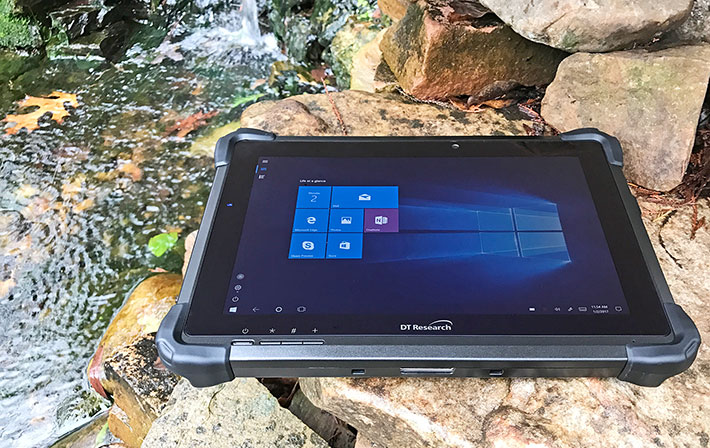
At the time, Daw Tsai Sc.D., president of DT Research, said "Mobile tablets are fast becoming the 'go to' computing device for the military and other field jobs. But as the use of mobile tablets has risen, we saw that users need the flexibility to use tablets in a variety of settings. Our new 2-in-1 ultra-rugged tablets can dynamically adapt to indoor and outdoor use, while remaining light and durable with our signature fully-integrated design."
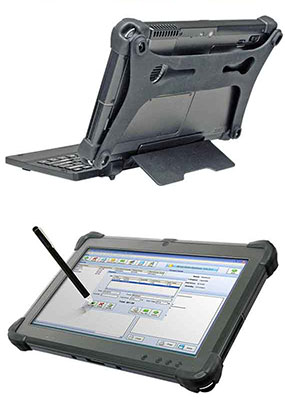 So why did DT Research launch two 2-in-1 versions of their tablets? In essence because that's where the market is going. Tablets have revolutionized the world, but primarily in the media consumption area; for most work, sitting down with a keyboard is still needed, and may always be needed. While it's possible to hook up a keyboard with most tablets, the implementation has to be just right in order for it to work. And that was the DT Research engineers' goal, to create a 2-in-1 solution that works (pictures below left are of the DT301S, those on the right of the slightly larger DT311H). So why did DT Research launch two 2-in-1 versions of their tablets? In essence because that's where the market is going. Tablets have revolutionized the world, but primarily in the media consumption area; for most work, sitting down with a keyboard is still needed, and may always be needed. While it's possible to hook up a keyboard with most tablets, the implementation has to be just right in order for it to work. And that was the DT Research engineers' goal, to create a 2-in-1 solution that works (pictures below left are of the DT301S, those on the right of the slightly larger DT311H).
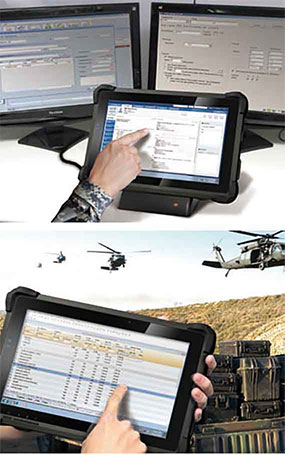 For a bit of history, 2-in-1s aren't new. They go back pretty much to the beginnings of pen computing and tablets over 20 years ago. But the designs never worked well enough to become popular beyond niche markets. For a bit of history, 2-in-1s aren't new. They go back pretty much to the beginnings of pen computing and tablets over 20 years ago. But the designs never worked well enough to become popular beyond niche markets.
Initially the problem was that packaging a full computer into a lightweight tablet just wasn't possible. So the attempted 2-in-1s were unwieldy and top-heavy.
In 2001, Microsoft promoted the Tablet PC concept, initially as pure tablets, but then as convertible notebooks. Those worked as laptops, but you could also flip the display around and make then into (rather thick and heavy) tablets.
Such convertible notebooks with rotating displays have had some success, but not on a larger scale. Most recently, cardboard-thin keyboards that attach magnetically to modern consumer and business tablets have made inroads, but generally don't make for truly practical solutions, and certainly not in industrial tablets.
Learning from the above history of failed or only marginally successful solutions, DT Research came up with the following conclusions:
- the keyboard must be a real keyboard people can actually use, not something that is nearly impossible to type on.
- the keyboard must have real, sturdy hinges for stability and a solid connection.
- the tablet and keyboard must reliably fit and work together.
- the keyboard and all pertaining accessories must be interchangeable within the company's 2-in-1 lineup.
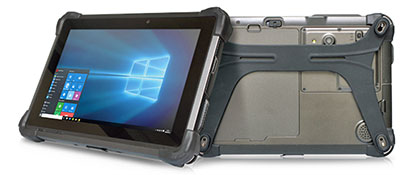 As for the tablet part of the DT301S 2-in-1 hybrid, this is one of the company's newest platforms. Sporting a modern, attractive design that instantly makes it clear that this is a rugged, businesslike piece of hardware, the DT301S is built on Intel's powerful "Skylake" 6th generation of Core processors, providing excellent performance in a fanless, economical package.
As for the tablet part of the DT301S 2-in-1 hybrid, this is one of the company's newest platforms. Sporting a modern, attractive design that instantly makes it clear that this is a rugged, businesslike piece of hardware, the DT301S is built on Intel's powerful "Skylake" 6th generation of Core processors, providing excellent performance in a fanless, economical package.
Measuring 10.7 x 7.5 x 0.86 inches and weighing under three pounds, the DT301S includes a full-slot Smart Card reader, has a hot-swappable 44.3 watt-hour battery, and comes with speedy dual-band 802.11ac WiFi and Bluetooth 4.0. Optionally available are a 4G LTE mobile broadband module, front and rear cameras, a 1D/2D barcode scanner, and an NFC/RFID reader. Overall, the rugged thin-and-light DT301 extends the company's focus well beyond its historic concentration on the point-of-sale market.
Taking a closer look at the DT Research DT301
Anyone who doesn't need the extra screen space of a "pro" size tablet, such as DT Research's own 11.6-inch DT311H, will feel instantly at home with the 10-inch class DT301S. Its footprint is reminiscent of the ubiquitous original iPad, and it offers the same full-HD 1920 x 1200 pixel resolution as the larger DT311H. Like most recent Windows tablets, the DT301 has capacitive multi-touch, and DT Research also offers an active digitizer with a high-precision digital pen.
Before we get deeper into the tablet itself, the pictures below show how DT Research implemented the 2-in-1 concept, what it all looks like, and how it can be used.
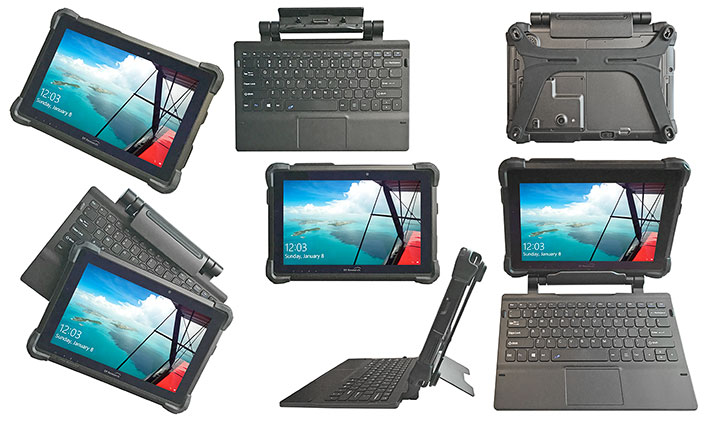
The detachable metal keyboard has 81 keys with the general look and feel of the slender Apple keyboard that has pretty much replaced the giant, clunky keyboards of yesteryear. There's a 3-1/4 x 2 inch capacitive touchpad with multi-touch capability. The standard 12 function keys also provide dedicated Windows 10 functions such as Cortana, share, connect, and settings.
The keyboard hinge is heavy construction and very sturdy. Keyboard and tablet communicate via the standard dock connector, which means no Bluetooth link that may or may not work. The keyboard has a flip-out stand that keeps the assembly stable while using the combo as a notebook computer. The design of the stand, however, is such that the angle of the tablet is fixed.
Like some of the other major players in the rugged tablet market, DT Research has over two decades' worth of experience in industrial and commercial tablets. As such, the company has an excellent sense of what works in various vertical markets and what doesn't, and, if warranted, they have historically been quick in adopting new trends and technologies.
As a result, it doesn't surprise that the DT301S skillfully combines elements of a traditional rugged device with those of a state-of-the-art consumer media tablet. Below is a look at the DT301S tablet from the front and from all four sides. Note how for a rugged tablet it's a comparatively slender design, and how all I/O is placed behind protective covers.

DT Research succeeded in creating a device that merges elegant, contemporary tablet looks with a brawny functional appearance. The protective bumpers are nicely integrated into the design and, unlike bumpers that are part of the housing, they are easy to replace. Physical controls are kept at a minimum. There are just four small buttons integrated into the design on the left lower part of the tablet. The power/sleep control is slightly recessed so that it isn't activated by mistake.
A trio of programmable buttons labeled *, #, and + are, by default, used to toggle the onscreen keyboard, toggle the Windows menu, and execute the "Security" modern day equivalent of the old alt-ctl-del. A utility allows programming these buttons to whatever the job requires. Anything else is done onscreen.
The images below show the right and left sides of the DT301S tablet with the hinged protective covers open. The cover doors click into place. Care must be taken to make sure they are actually locked.
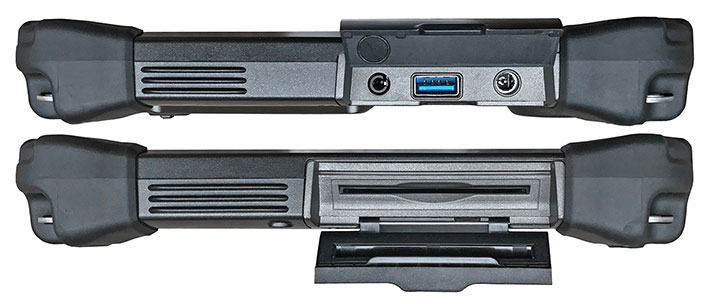
Rugged tablets usually don't have a lot of onboard connectors, and the DT301S is no exception. The tablet offers a 3.5mm audio jack, a power jack, and a single standard USB 3.0 port. There are small white symbol labels underneath the protective door, but not outside. That would be a problem if there were several similar micro ports; here, the ports are obvious.
Underneath the door on the right side is the Smart Card reader slot. The ribbing next to the doors looks like it could be cooling fins or heat exchanger vents, but they are just decorative elements in the plastic antenna covers. No need for heat exchanger vents here; the DT301S doesn't have a fan.
Design and construction
No RuggedPCReview examination of a rugged device would be complete without taking it appart (for the rationale of examining the guts of a machine, see Why we take things apart and show what's inside). In our experience, products from established, reputable manufacturers of rugged mobile computing gear have nothing to fear from a detailed interior inspection. These devices are designed from the ground up to be rugged, and we seldom come across unpleasant surprises. But sometimes we do notice something that catches our attention and we may discuss the matter with the manufacturer.
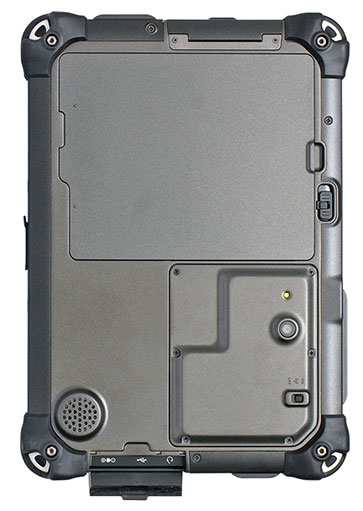 The picture to the right shows the backside of the tablet, with its rubber hand strap removed. The picture to the right shows the backside of the tablet, with its rubber hand strap removed.
Taking the DT301 apart isn't totally trivial. First you undo six small Philips screws to remove an access cover to an expansion slot compartment. It's not just a cover, though, as it also houses the rear documentation camera, a radio on/off switch, a small battery, and it also serves as a heat dissipation sink for the tablet's solid state disk. All of this requires three cables that must be disconnected from the motherboard underneath before proceeding further.
The battery is custom-designed for the DT301 and is part of the tablet, i.e. there is no cover over it. The battery compartment itself isn't sealed, but the connector between the battery and the insides of the tablet is, and that's all that matters. The battery is securely held in place with a combination friction lever/lock.
As far as power goes, the DT301 battery uses Lithium-Ion technology and is rated 7.2Volts and 6,150mAH, which makes for 45 watt-hours. The advantage of this type of battery design is that it's easy to offer optional higher capacity batteries (that then may protrude a bit).
Next it's time to remove the plastic antenna covers, the protective I/O covers, and the corner rubber bumpers. That's not inherently difficult, but requires undoing a variety of different screws and bolts. Once that is done, the two halves of the DT301 come apart fairly easily. Some caution is required though as there are three cables (power, CAC reader, and speaker) that must be disconnected before the two halves fully separate.
The overall construction of the DT301 now reveals itself. Except for the front bezel overlay, pretty much the entire tablet is solid magnesium. Solid as in beefy and heavily reinforced, not the fragile lightweight kind sometimes found in premium consumer tablets. Below you can see the two structural halves of the DT301S, top on the left and bottom on the right.

The ever important sealing between the two magnesium halves is via a complex 3D tongue-and-groove design that goes around the perimeter. In the groove sits a replaceable rubber seal.
All major components are mounted on the two sides of the magnesium front half of the tablet, display on one side and electronics on the other. The motherboard measures about 6.5 x 4 inches. It's clearly a custom design for this particular tablet, cut and contoured to fit precisely into its space inside the magnesium frame.
What immediately catches the eye is a curved length of copper heat tubing embedded in the magnesium frame. That's there because of the DT301's fanless design. That's right: no fan despite the powerful 2.5GHz Intel dual-core, quad-thread i7-6500U processor that can reach 3.1GHz on turbo boost. While the advanced Skylake chip has a TDP (Thermal Design Power) of just 15 watts, that's still quite a bit of heat to dissipate, and being able to do that without a fan is remarkable.
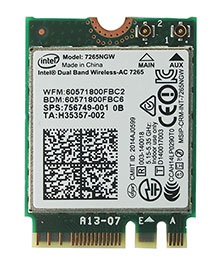 Of components and modules, we see an Intel Dual Band Wireless-AC 7265 2x2 WiFi and Bluetooth module. For WiFi, it's about three times faster than 802.11n, up to 867 Mbps with its two antennas both at the transmit and the receive end. Of components and modules, we see an Intel Dual Band Wireless-AC 7265 2x2 WiFi and Bluetooth module. For WiFi, it's about three times faster than 802.11n, up to 867 Mbps with its two antennas both at the transmit and the receive end.
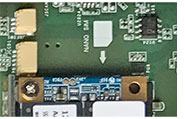 Mass storage is provided by a 128GB mSATA solid state disk module, sitting on top of a tiny nano-SIM slot (see picture to the left). Mass storage is provided by a 128GB mSATA solid state disk module, sitting on top of a tiny nano-SIM slot (see picture to the left).
A full-size mini-PCIe slot is available for a mobile broadband module or whatever other connectivity may be required. Whatever I/O there is — USB 3.0, an audio jack, and power — is edge-mounted on the motherboard.
There are a few visible wires, all leading to the various antennae that are located outside of the sealed metallic inner sanctum of the tablet. That's because antennae can't work inside a full metal enclosure. As is usually the case, parts of the motherboard and other electronics are underneath metal shielding. What's impressive is that each of those shields is individually engraved with its number, purpose and that it's for the DT301.
The overall layout is logical and well done. This is certainly no generic design. Everything is custom and as complex and refined as it needs to be to get the job done. Sealing a device of this complexity isn't easy, not with four different radio antenna that all must be outside the actual interior enclosure. To still reach IP65 ingress protection is quite an achievement.
Powered by Intel 6th Generation "Skylake" processors
When it comes to a tablet's processor, newer and faster is always better, and having a late model chip under the hood is a competitive advantage. That said, Intel has been struggling the last few years to keep up with its self-imposed pace of progress.
That's mainly because a long time ago one of Intel's co-founders, Gordon Moore, stated that the number of transistors on a given surface area would double every 24 months. This became known as Moore's Law, and Intel built its processor development strategy around it. In what Intel calls their "Tick-Tock" cycle, the company has continuously been shrinking transistor size (so that more fit onto a chip) one year, and then redesigning and optimizing the circuitry the next to take advantage of the shrunken components. In this system, Skylake is a "tock" processor optimization after the 5th generation "Broadwell" "tick" that shrank lithography.
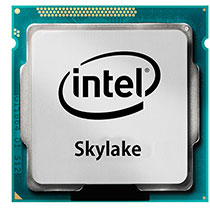 That rapid-fire succession of processor generations makes being "current" with Intel chips a fleeting proposition, and new though the processor circuitry inside the DT301S is, Intel has already released the next generation, Kaby Lake. Tuning out the Tick-Tock cycle hype, though, with Skylake Intel did make their processors do more work in fewer cycles and handle more data per cycle. That was done via optimized parallel processing that keeps all available cores busy rather than having some just idle along. That rapid-fire succession of processor generations makes being "current" with Intel chips a fleeting proposition, and new though the processor circuitry inside the DT301S is, Intel has already released the next generation, Kaby Lake. Tuning out the Tick-Tock cycle hype, though, with Skylake Intel did make their processors do more work in fewer cycles and handle more data per cycle. That was done via optimized parallel processing that keeps all available cores busy rather than having some just idle along.
But given that the DT301S is a new design and DT Research always seems willing to provide its customers with the latest available technology, why did they not go all the way and use a 7th generation Kaby Lake chip? Probably because Kaby Lake does not officially support anything before Windows 10, and not everyone is ready to use Windows 10. As of this writing (January 2017), 48% of all desktop and laptop users still have Windows 7, and only 24% Windows 10 (see NetMarketShare). Which means that DT301S customers with their Skylake chip can exercise their Windows 7 Professional "downgrade" option.
As is, we ran a pre-production DT301S tablet through our standard PassMark benchmark suite to test its performance in various categories. To provide an idea of where the DT301S with its Skylake Core-i7 chip fits in we're also listing the results of its 11.6-inch DT311H sibling, Xplore's XSLATE R12 and B10 tablets, as well as Dell's Latitude 12 Rugged Tablet, GammaTech's 11.6-inch Durabook R11, and Getac's 11.6-inch F110 tablet in 2015 trim (it's been upgraded to Skylake since). Here are the results:
|
DT Research DT301S Benchmarks and Comparisons
|
|
PERFORMANCE COMPARISON
|
DT Research
|
DT Research
|
Xplore
|
Xplore
|
Dell
|
GammaTech
|
Getac
|
|
Model
|
DT301S
|
DT311H
|
XSLATE R12
|
XSLATE B10
|
12 Tablet
|
R11
|
F110
|
|
Processor Type
|
Intel Core
|
Intel Core
|
Intel Core
|
Intel Core
|
Intel Core
|
Intel Core
|
Intel Core
|
|
Processor Type: Intel
|
i7-6500U (G6)
|
i7-5500U (G5)
|
i7-7500U (G7)
|
i5-5350U (G5)
|
M-5y71 (G5)
|
i5-5200U (G5)
|
i7-5500U (G5)
|
|
Code name
|
Skylake
|
Broadwell
|
Kaby Lake
|
Broadwell
|
Broadwell
|
Broadwell
|
Broadwell
|
|
Thermal Design Power (TDP)
|
15 watts
|
15 watts
|
15 watts
|
15 watts
|
4.5 watts
|
15 watts
|
15 watts
|
|
CPU Clock
|
2.50GHz
|
2.40GHz
|
2.70GHz
|
1.80GHz
|
1.20GHz
|
2.20GHz
|
2.40GHz
|
|
CPU Turbo
|
3.10GHz
|
3.00GHz
|
3.50GHz
|
2.90GHz
|
2.90GHz
|
2.70GHz
|
3.00GHz
|
|
CPU Cores/Threads
|
2/4
|
2/4
|
2/4
|
2/4
|
2/4
|
2/4
|
2/4
|
|
Graphics
|
Intel HD Graphics 520
|
Intel HD Graphics 5500
|
Intel HD Graphics 620
|
Intel HD Graphics 6000
|
Intel HD Graphics 5300
|
Intel HD Graphics 5500
|
Intel HD Graphics 5500
|
|
CPU Mark
|
4,277.1
|
4,135.1
|
4,940.7
|
3,845.5
|
2,683.8
|
3,646.6
|
3,864.1
|
|
2D Graphics Mark
|
473.4
|
468.6
|
613.9
|
416.9
|
370.6
|
423.7
|
514.7
|
|
Memory Mark
|
1,338.3
|
1,192.3
|
1,563.3
|
1,241.2
|
952.2
|
1,052.3
|
1,215.6
|
|
Disk Mark
|
3,740.1
|
3,773.2
|
4,438.2
|
4,946.9
|
3,595.2
|
3,901.1
|
3,790.4
|
|
3D Graphics Mark
|
468.9
|
545.2
|
568.8
|
460.1
|
265.6
|
337.1
|
399.1
|
|
Overall PassMark
|
2,266.2
|
2,216.8
|
2,657.2
|
2,364.7
|
1,694.0
|
2,026.7
|
2,140.1
|
The tablets listed above are all premium high-performance industrial tablets that pack a considerable punch. There is remarkable performance parity in that class, and so bottomline benchmark numbers (PassMark numbers, anyway) usually come down to processor generation and how quick the storage subsystem is.
As is, in our testing the DT Research DT301S performed at a slightly higher level than all but one of the tablets equipped with 5th generation "Broadwell" chips, but wasn't quite as quick as the sole 7th generation product. Impressively, the DT301 earned two silver (PassMark CPU, PassMark 3D Graphics) and a bronze (CrystalMark Overall) medal in our recent "Speed Demon" feature on the fastest rugged tablets ever benchmarked by RuggedPCReview.
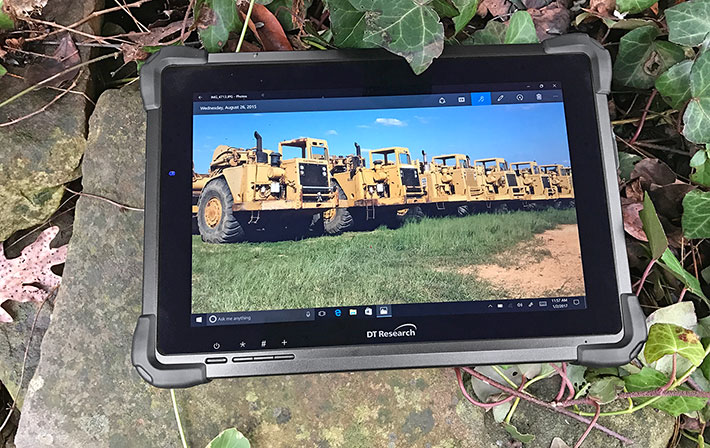
Power consumption
 What impact does the DT301's considerable performance and its bright, vibrant screen have on power consumption and battery life? As is our standard procedure, we used Passmark Software's BatteryMon power management benchmark utility to measure the DT Research tablet's power draw under various operating conditions. What impact does the DT301's considerable performance and its bright, vibrant screen have on power consumption and battery life? As is our standard procedure, we used Passmark Software's BatteryMon power management benchmark utility to measure the DT Research tablet's power draw under various operating conditions.
First we set the Windows 10 power options to "Balanced" and display brightness to its lowest setting (0%). That way we saw an idle power draw of 5.7 watts. We then cranked the backlight up to 50%, and draw increased to 6.6 watts. Then we cranked brightness all the way up to 100% and saw 7.7 watts. That's with the tablet being awake, just idling along.
Next we set the Windows 10 power options to "Power Saver" and display brightness at its lowest setting (0%). That way we saw an idle power draw of 6.7 watts. We then cranked the backlight up to 50% and draw increased to 7.3 watts. Then we cranked brightness all the way up to 100% and saw 8.1 watts.
|
DT Research DT301S Power Draws (at idle)
|
|
Backlight level
|
Lowest (0%)
|
50%
|
Maximum (100%)
|
|
Power Saver
|
6.7 watts
|
7.3 watts
|
8.1 watts
|
|
Balanced
|
5.7 watts
|
6.6 watts
|
7.7 watts
|
|
Max Performance
|
6.4 watts
|
7.4 watts
|
8.5 watts
|
Finally, we set the tablet to "Max Performance." At the lowest brightness we saw an idle power draw of 6.4 watts. At 50% brightness draw increased to 7.4 watts. And at the maximum brightness setting, electric draw reached 8.5 watts.
What do those power draw figures mean in terms of projected battery life? The thin Li-Ion battery of the DT301S has a capacity of 44.3 watt-hours. Dividing that by the 5.7 watt minimum observed draw would indicate 7.8 hours of battery life with the system staying awake the whole time. In the maximum performance settings and with the backlight going at 100%, theoretical battery life would drop to 5.2 hours.
Note that the power draw in our review unit was lowest in its "balanced" power setting, and not as expected in the "power saver" setting. It's conceivable that final production units may have lower draw yet.
Bright, excellent 10.1-inch full HD display
The DT301S tablet's 10.1-inch display offers full 1920 x 1200 pixel resolution, making for 16:10 aspect ratio and a sharp 224 pixels per inch. That's the same pixel density as Apple's retina iMacs and MacBooks. The display surface is of the glossy variety seen today on virtually all tablets and smartphones. Indoors, the DT301S display is a very pleasant to use and work on.
But since many DT301S tablets will likely spend much time outdoors and on the job, how well does the display perform outdoors?
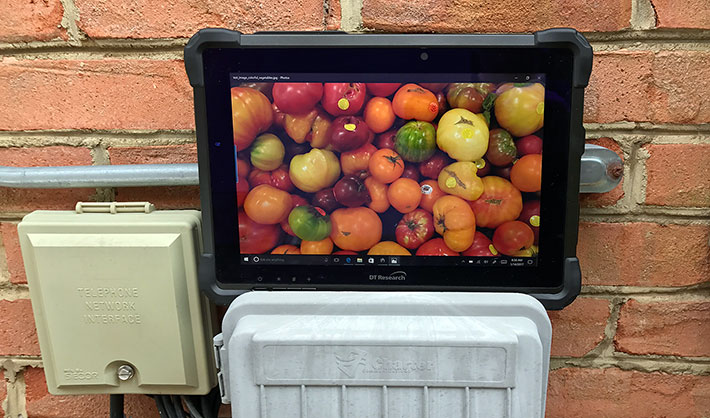
Not too terribly long ago, outdoor viewability was the weak point of most rugged mobile computing devices. Display technologies came and went, none yielding acceptable results. Eventually the industry decided that modifying conventional transmissive LCDs for daylight and sunlight use was the best available way to go.
That's done by reducing the display's internal reflection of ambient light so that, in conjunction with a reasonably strong backlight, there is enough contrast to make the screen viewable outdoors. This reduction of internal reflection is accomplished via a combination of polarizers, filters, coatings and elimination of air spaces between the various layers of the LCD.
Almost all mobile devices use this technology today but the exact implementation varies from manufacturer to manufacturer. As does the strength of the backlight (a stronger backlight means a larger battery or shorter battery life).
DT Research has plenty of experience in this and it shows. The DT301S display is not only excellent indoors, it also remains quite usable outdoors. The tablet's backlight is sufficiently strong to boost contrast and viewability in broad daylight, without being so strong as to quickly drain the battery in prolonged outdoor use.
Viewing angle is another display quality that we consider extremely relevant in tablets. It's important because tablets are held in various ways and looked at from various angles. What's on the screen must remain easily viewable regardless of the viewing angle, and there must not be any changes in color, contrast or brightness. That doesn't matter much when using notebooks or desktops because one genrally looks at the display head-on, at an steady angle. With tablets it's different.
The DT301S display scores very high in that regard. It offers perfect horizontal and vertical viewing angles. Colors, brightness and contrast remain true and unchanged when viewed from above, below, left and right.
The picture above shows how good the perceived image on the DT301S display can be under ideal conditions, i.e. without background that can reflect on the display, and without direct sunlight. The picture below shows that outdoors lighting and external reflections affect even the best current displays. Both pictures were taken in broad daylight, midday, but without direct sun. Varying the viewing angle by a few degrees so that the sky reflects, and the image becomes less viewable and assumes a distinct blue cast from the coatings.
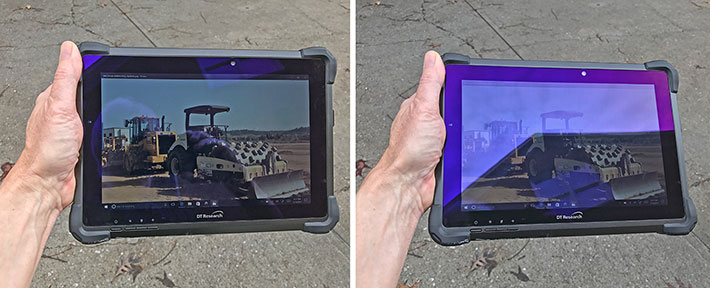
Overall, the display of the DT301S is about as good as it gets with current display technology.
Digitizer: capacitive multi-touch and (optional) active pen
Like a growing number of productivity tablets, the DT301S has both 10-point capacitive multi-touch as well as an optional active pen. That's because while capacitive touch is optimal for the tapping, panning, pinching and zooming popularized by smartphones and media tablets, precision operations, artwork, and a lot of legacy Windows software greatly benefit from a pen. Here's a bit of history on that:
Using desktop operating systems on a tablet means somehow making things work without the keyboard and mouse they were designed for. That has always been a challenge. The earliest tablets in the beginning of the 1990s mostly had active digitizers with a special pen. Those pens were expensive and, lacking touch, the tablets were useless if the pen was misplaced or lost.
For those reasons, many tablets switched to resistive touch that worked with a cheap plastic stylus or even fingers. Resistive touch, however, lacked precision and was a poor match for use with Microsoft Windows. In the early 2000s, Microsoft improved active pen support in its Windows XP Tablet PC Edition initiative, but it wasn't enough to make tablets popular.
 Widespread tablet adoption only came after first the iPhone and then the iPad popularized capacitive multi-touch with its effortless panning and pinching and zooming. Even capacitive touch, however, had a rough start on Windows because legacy Windows simply was designed for use with a mouse and not a pen. Microsoft tried to address that first with Windows 8 and then 8.1, but it wasn't until Windows 10 that capacitive touch became more feasible for Windows tablets. Widespread tablet adoption only came after first the iPhone and then the iPad popularized capacitive multi-touch with its effortless panning and pinching and zooming. Even capacitive touch, however, had a rough start on Windows because legacy Windows simply was designed for use with a mouse and not a pen. Microsoft tried to address that first with Windows 8 and then 8.1, but it wasn't until Windows 10 that capacitive touch became more feasible for Windows tablets.
With Windows 10, users can toggle between tablet mode and desktop mode (see screen shots below). The two modes have a similar look, but using them is quite different. Desktop Mode has the start menu, windows, and everything needed to use Windows legacy applications and tools. Tablet Mode (what Microsoft initially called "Metro" in Windows 8) means full-screen apps and almost everything is touch-optimized. It's still a work in progress, but definitely a step in the right direction.

Ever since the emergence of the Tablet PC over a decade ago, Windows has included handwriting recognition and a number of pen and touch utilities. Examples are the Math Input Panel, Snipping Tool, and Windows Journal. The latter is no longer in Windows 10 because of security concerns over Journal's JNT file format, but Journal can still be downloaded from Microsoft (here). Other pen utilities are still present, and they are now joined by Windows Ink.
To launch Windows Ink you tap the new pen icon next to the keyboard icon to access ink-enabled Sticky Notes, Sketchpad, and Ink Workspace. They are basic and works in progress, but they are additional evidence that Microsoft, slowly but surely, morphs Windows into a more touch and pen-friendly operating environment. I mention "pen" because Microsoft's initial Tablet PC initiative was very much pen-centric, whereas capacitive multi-touch remains very much finger touch-oriented.

DT Research addressed this issue in the DT301S by giving it both 10-point capacitive multi-touch and a high-precision active pen that does not need a battery. They used the eGalaxPen that is pressure-sensitive (which means it's great for art and elegant writing) but, unlike the ubiquitous Wacom pen, does need a AAAA battery.
The screen shots below show some of the pen and ink tools. Clockwise starting from the upper left, the Windows Ink Workspace, the Sticky Notes, and two examples of how one can use the Windows 10 Sketchpad.

Most tablets currently available with active pens use either Wacom or Microsoft's nTrig, but there's much to like about the eGalaxPen. Ink goes on very smoothly and there is none of the annoying "rubber-banding" delay that mars the experience of using other pen technologies. Pressure-sensitivity works smoothly and elegantly in apps that support it, as does the erase function. The pen comes to life as soon as it's close to the tablet and that also automatically turns off finger touch. If not used, the pen turns itself off after a couple of minutes so as to conserve battery. The pen tip makes a clicking sound when pressure is applied during use, and we had to get used to that.
Unlike other active pens, the eGalax pen doesn't do "hovering" where the cursor follows the tip of the pen even if the pen does not touch the surface. Hovering lets the user know where, exactly, the computer senses the tip of the pen. Hovering, though, is also quite annoying since real pens don't have a little cursor following them. So the eGalaxPen actually feels much more like a real pen.
Optional cameras
As is usually the case these days with tablets, smartphones and notebooks, the DT301S has integrated imaging capabilities via dual cameras. They are optional since not everyone needs or even wants cameras in their tablet in this era of mounting hacking and security concerns. Available are a 2.0 megapixel front-facing vidcam for conferencing, and a rear-facing 5.0 megapixel documentation camera with LED flash. That one is for workflow documentation and the like.
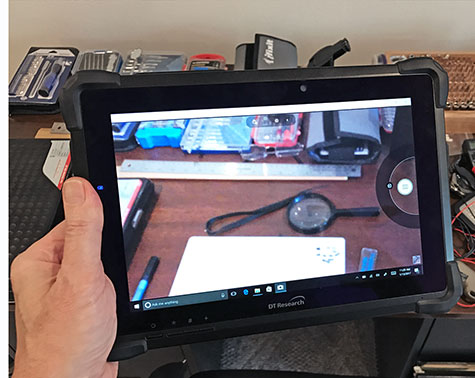 In our testing, the standard Windows Camera app defaulted to 1920 x 1080 pixel, despite the camera's larger 5mp imager. Video, likewise, recorded at 1920 x 1080, also known as 1080p. In our testing, the standard Windows Camera app defaulted to 1920 x 1080 pixel, despite the camera's larger 5mp imager. Video, likewise, recorded at 1920 x 1080, also known as 1080p.
In still photography, auto-focus worked fine, images were reasonably sharp, and the camera did not over-compress images. Video was sharp enough for many purposes and did not lag behind.
What continues to baffle us is that the official Windows 10 Camera app does not provide access to a computer's full camera capabilities. Controls for still pics were limited to time delay (2/5/10 seconds), time lapse shooting, aspect ratio (16:9 or 4:3, and exposure compensation.
The image to the right shows how the DT301S can be used to document work or problem areas on a service call. Unlike on the very small screens of most dedicated cameras, and the still fairly small displays of smartphones, using the DT301S as a 10-inch viewfinder shows makes it much easier to see what, exactly, you're taking a picture of.
The pictures below were taken with the DT301's camera in its 16:9 aspect ratio resolution, which made for 1920 x 1080 pixel 2mp pictures (click on the sample pics for a full-size version of the entire picture compilation).

The good news about integrated cameras such as the DT301S can be equipped with is how much better they are than they used to be just a few short years ago. What used to be little more than technology demonstrations and proofs of concept can now be used for real work. It does require a bit of practice and premium smartphones can do better, but there's much to be said to have all required functionality in one device rather than having to take along multiples.
I should mention that DT Research did include its own significantly more elaborate DTSMCap imaging utility. It wasn't optimized yet in our pre-production sample, but when completed should allow much more complete use of the integrated cameras.
Docks, accessories, and peripherals
Since the DT301S doesn't have much onboard wired connectivity, DT Research offers a handy, compact optional desktop dock that adds dual DisplayPort outputs that support 4K UHD resolution, four USB ports, and RJ45 LAN.
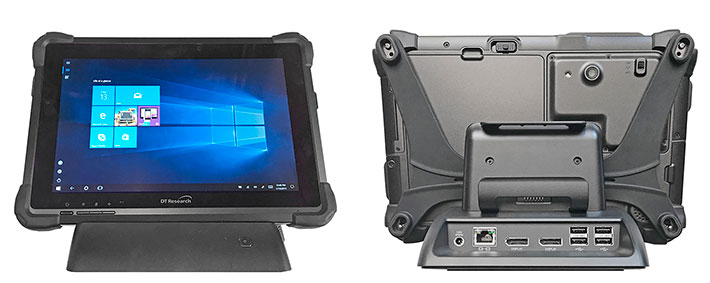
Other accessories include a DisplayPort-to-DVI adapter that also enables running dual external displays off the dock; a wall/vehicle cradle with LAN pass-through and two USB ports that accepts power through a cylindrical 19V plug or a 12V-24V pluggable Phoenix terminal block connector. We've covered the 2-in-1 keyboard earlier in this review, and DT Research also offers a separate keyboard tray with a USB keyboard for use with the wall/vehicle cradle.
Elegant tablet that can take a beating
Hundreds of millions are using tablets now, but most of those are too fragile for field or even enterprise use. That's why there are rugged tablets like the DT301S. Problem is that making a tablet rugged increases cost, size and weight. So designers and manufacturers of such heavy duty tablets must find just the right balance for their products: Tough enough for the job, attractive enough to appeal, but still affordable and handy enough for effortless use.
Thanks to its ABS+PC polycarbonate and magnesium-aluminum alloy construction, the DT301S is a lot sturdier and tougher than its light and elegant design suggests.
 The specs state IP65 sealing, which means the device is fully protected against dust, and also protected against low pressure water jets from all directions, albeit with, according to the spec, "limited ingress permitted." The specs state IP65 sealing, which means the device is fully protected against dust, and also protected against low pressure water jets from all directions, albeit with, according to the spec, "limited ingress permitted."
IP65 is pretty much the expected norm for tablets in this class. In essence, IP65 here means you can use it in the rain, it won't mind sitting in a puddle or being washed off, but dropping it into a stream isn't a good idea. And do make sure the protective doors are closed when using the tablet in wet conditions.
The standard operating temperature range is a very wide -4 to 140 degrees, making the system deployable almost anywhere, including in commercial freezers.
DT Research also claims MIL-STD-810G testing for drop, shock and vibration, as well as MIL-STD-461F certification for EMI and EMC tolerance. Here it would be good to see more detailed information in the spec sheet and promotional materials. Customers are interested in rugged tablets because they can handle more abuse, so specific information on just how much abuse should be included.
Subjectively, despite its elegant, contemporary design, the DT301S does look as tough and rugged as it actually is. As our internal inspection revealed, with its heavy-duty magnesium frame inside and the hefty rubber corner guards outside, the DT301S can handle a good deal of punishment. The tablet feels solid and trust-inspiring, too, without any flex or creaking. That said, it would be good to know what sort of strengthened glass DT Research used and also what sort of scratch resistance the metallic surfaces provide.
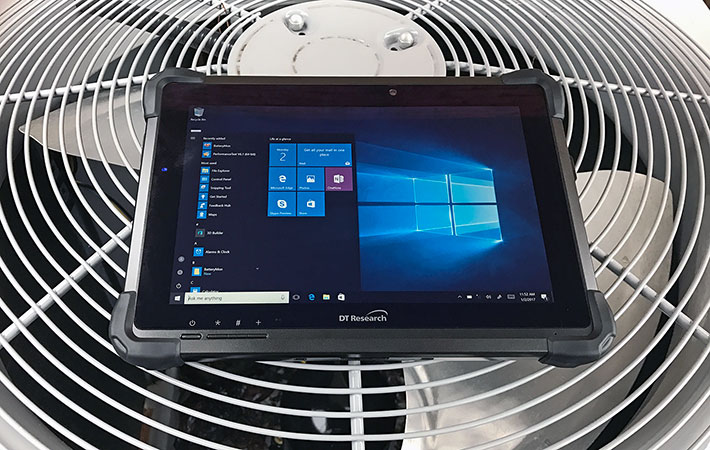
Summary: DT Research DT301S rugged 2-in-1 tablet computer
With the light and compact DT301S, DT Research offers a state-of-the-art, Intel Skylake-powered thin-and-light tablet that's tough enough to be deployed in a vast array of applications that require more durability and resistance to adverse environmental conditions than run-of-the-mill consumer tablets can provide.
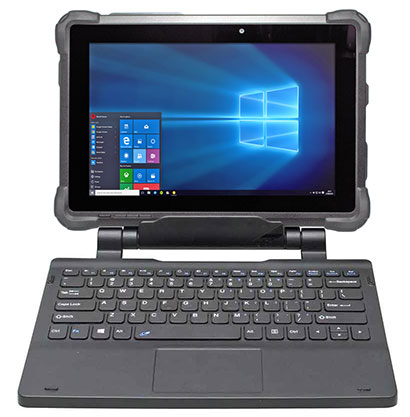 As a tablet, the DT301S offers a bright, daylight-viewable 10.1-inch capacitive multi-touch display with full HD resolution, perfect viewing angles from all directions, and an optional active pen with a pencil-thin, pressure-sensitive tip. As a tablet, the DT301S offers a bright, daylight-viewable 10.1-inch capacitive multi-touch display with full HD resolution, perfect viewing angles from all directions, and an optional active pen with a pencil-thin, pressure-sensitive tip.
Weighing just under three pounds, the attractively designed magnesium-alloy tablet is tough and well protected.
Equipped with a full-size USB 3.0 port, 3.5mm audio jack, and a Smart Card/CAC reader, the DT301S can be custom configured with dual cameras, 1D/2D barcode scanning, HF/RFID as well as discrete GNSS and mobile broadband.
The optional detachable keyboard converts the DT301S into a hybrid 2-in-1 device that can instantly provide full laptop functionality without the extra bulk and weight of a permanently attached keyboard. The addition of a 2-in-1 version of the DT301S is timely and certainly makes the platform that much more attractive.
An optional desktop dock provides dual DisplayPort outputs capable of 4K UHD resolution, four USB ports, and RJ45 LAN. A wall/vehicle cradle with USB keyboard tray is available as well.
All of this combines into a modern, state-of-the-art Windows 10 2-in-1 tablet hybrid solution with performance commensurate with that required for a broad range of even the most demanding field applications. -- Conrad H. Blickenstorfer, January 2017
DT Research DT301S Specs:
| Status |
Added 07/2016, full review 01/2017
|
| Type |
Rugged Mobile 2-in-1 Windows tablet
|
| Processor |
Intel 6th generation "Skylake" Core i7-6500U (also available with Core i5-6300U)
|
| CPU Speed |
i7-6500U: 2.5GHz (3.10GHz turbo); i5-6300U: 2.4GHz (3.00Ghz turbo) |
| Graphics |
Intel HD Graphics 520, 300/1,050MHz
|
| CPU Thermal Design Power |
15 watts |
| OS |
Microsoft Windows 7 Professional or Windows 10 IoT Enterprise
|
| Memory |
8GB or 16GB DDR3L
|
| Display |
Outdoor-viewable TFT with LED backlight, anti-reflection coating |
| Display Size/Resolution |
10.1-inch/1920 x 1200 pixel FHD (224 ppi) |
| Digitizer |
Capacitive multi-touch, optional active digitizer/pen with replaceable 1.5mm tip (uses AAAA battery) |
| Keyboard |
Optional detachable 81-key keyboard, 3 programmable buttons, RF button |
| Navigation |
Stylus, touch |
| Storage |
128GB to 512GB Flash
|
| Expansion slots |
1 x Smart Card reader, 1 x Nano-SIM card |
| Housing |
ABS+PC bezel; magnesium structure/frame |
| Size |
10.7 x 7.5 x 0.86 inches (272 x 190 x 22 mm) |
| Weight |
2.86 lbs. (1.3kg) |
| Operating temperature |
-4° to 140°F (-20° to 60°C)
|
| Ingress protection |
IP65 |
| Altitude |
unknown
|
| Drop/shock |
MIL-STD-810G (4-foot drop) |
| Vibration |
MIL-STD-810G |
| Regulatory |
FCC Class B, CE, RoHS compliant |
| EMC |
MIL-STD-461F |
| Power |
Rechargeable, replaceable externally accessible 7.2V 6,150 mAH Li-Ion (44.3 watt-hours), hot-swappable
|
| Cameras |
Optional: front-facing 2mp camera, rear=facing 5mp back AF camera with LED flash
|
| Data capture |
Optional: 1D/2D barcode scanner, HF/RFID 13.56MHz reader
|
| Sensors |
Accelerometer
|
| Interface |
1 x USB 3.0, 1 x 3.5mm audio in/out, power
|
| Wireless options |
Intel Dual Band Wireless-AC 802.11ac WiFi, Bluetooth v4.0 LE (optional Class 1 (1,000 feet)), optional: 4G LTE, HSPA+, GSM/GPRS/EDGE, EV-DO, Rev A and 1xRTT; ublox M8 GNSS module
|
| Price |
Inquire |
| Product page |
DT301S web page |
| Spec sheet |
 DT301S brochure (PDF) DT301S brochure (PDF)
|
| Warranty |
1, 2, or 3 year extended or no-fault options
|
|
Contact
|
DT Research
2000 Concourse Drive
San Jose, CA 95131, USA
Tel: (408) 934-6220
Fax: (408) 934-6222
Web: www.dtresearch.com
|
(copyright 2017 RuggedPCReview.com)
|






